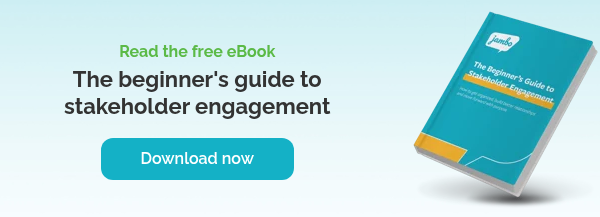
Stakeholder engagement plays a crucial role in the success of any project or organization. How you communicate, collaborate, and build relationships with people impacted by your work can shape outcomes and influence long-term support. But what does stakeholder engagement look like in practice, and why is it so important? In this article, we'll define stakeholder engagement, how to identify stakeholders, the importance of stakeholder engagement, and tips to help you strengthen your approach.
Table of contents:
1. What does stakeholder engagement mean?
2. Who are the stakeholders to engage with?
3. Why is stakeholder engagement important?
4. What are the different levels of stakeholder engagement?
5. How do you engage effectively with stakeholders?
What is stakeholder engagement?
Stakeholder engagement is the process of identifying, informing, and collaborating with individuals or groups who are interested in or can influence a project, decision, or organization. Its core purpose is to involve these stakeholders to gather their input, feedback, and insights, resulting in better decision-making, stronger support for initiatives, and improved outcomes for everyone involved. In short, stakeholder engagement matters because your stakeholders matter: their knowledge, participation, and support can make the difference between success and failure.
Engaging with stakeholders offers a range of benefits, including building trust through clear communication, promoting transparency, and boosting accountability. It also helps uncover crucial information, leads to better and more sustainable decision-making, and empowers all stakeholders to have a meaningful voice in your project's success.
Who are the stakeholders to engage with?
- Internal stakeholders
Internal stakeholder engagement is about keeping the people inside your organization, your team, managers, and leadership, in the loop and actively involved. It means creating open, honest communication channels so everyone knows what's happening, feels heard, and is motivated to work towards the same goals. - External stakeholders
External stakeholder engagement is the process of interacting and communicating with individuals or groups outside an organization who are affected by or have an interest in its activities. External stakeholders include customers, suppliers, investors, community members, regulators, partners, and the general public.
Identifying stakeholders to engage with
Identifying stakeholders to engage with starts by mapping out everyone who is affected by or can influence your project or organization. But how do you ensure you have not missed anyone important or prioritized the right people? Here's how to do it:
1. Stakeholder identification
According to the IFC, "Stakeholders are persons or groups who are directly or indirectly affected by a project, as well as those who may have interests in a project and/or the ability to influence its outcome, either positively or negatively."¹
Compiling your list of stakeholders is called stakeholder identification and is an essential step in your stakeholder engagement journey. The stakeholder identification process is where we determine:
- With whom do we need to engage
- In what capacity
- In what way
2. Stakeholder mapping
The next step in your stakeholder engagement journey is mapping your stakeholders into their appropriate groups, based on the following classifications:
- Stakeholder authority/power
- Stakeholder interest level
Based on Mendelow's Power-Interest Matrix, this matrix helps you identify your "key players" and decide which tactics are best for engaging with each category of stakeholders.
Access these free tips on how to map your stakeholders→
Why is stakeholder engagement important?
By engaging with customers, partners, regulators, and communities, you can better understand stakeholder needs, manage risks, and align your projects with broader expectations. This approach not only enhances your reputation but also drives long-term success.
-
Building trust and transparency: Open communication fosters trust, essential for any organization's reputation. When stakeholders feel heard and informed, they're more likely to support your initiatives and remain loyal.
-
Reducing risks: Understanding stakeholder concerns early on helps identify potential risks, whether regulatory, environmental, or social, that could impact a project or your business at large. Addressing these risks early can save time, money, and headaches.
-
Enhancing decision-making: External stakeholders often bring unique perspectives and expertise. Their feedback can improve project design, operational decisions, and strategic planning by highlighting opportunities or challenges your internal team might have missed.
-
Meeting regulatory and social expectations: Many industries face strict regulations. Engaging with regulators and community groups ensures you stay compliant and support social license to operate, reducing conflicts and delays.
-
Driving innovation and collaboration: Active stakeholder engagement can open doors to partnerships, shared knowledge, and collaborative projects that benefit everyone involved.
Learn 10 reasons why effective stakeholder engagement is crucial to your project's success and reputation →
What are the different levels of stakeholder engagement?
The Spectrum of Public Participation, developed by the International Association for Public Participation (IAP2), is an excellent tool for identifying the best level of engagement (or participation) for your stakeholder categories.
The IAP2 Spectrum identifies five different levels of participation:
- Inform
- Consult
- Involve
- Collaborate
- Empower
For example, a low-power/low-interest stakeholder is not likely to influence or be concerned with your project and might only need to be informed (often with one-way communication).
Your "key player" stakeholders (high power/ high interest) have a much greater potential to impact your project and, based on the IAP2 levels of engagement, may need to be consulted, involved, collaborated with, and/or empowered, depending on the circumstance or your organization's vision for engagement.
Once you decide on your level of engagement, you're ready to choose your specific engagement tactics.
Your tactics are simply your chosen method of engagement. For example, emailing stakeholders can be a great two-way communication method.
If you're new to stakeholder engagement, this practical guide is the perfect starting point. Download the free resource below →
How to ensure effective stakeholder engagement
Your engagement must be meaningful to ensure you build strong relationships with your stakeholders. The foundation of successful relationships is trust, and to build confidence, stakeholders need to feel like their issues and concerns are valued and heard.
For stakeholders to feel valued and heard, you need to remember what has been said and promised in the future.
Keeping a record of your stakeholder interactions, your stakeholder issues and stakeholder commitments can help ensure this is possible and, in turn, allows stakeholders to build trust in your organization.
However, trusting relationships cannot be maintained if there is no way to ensure everyone is on the same page. Trust is essential for managing stakeholder engagement. Building stakeholder relationships is essential to invest in your organization's long-term success, whether in a long-term or short-term project.
Stakeholder relationships are not "one and done." You could quickly reencounter the same stakeholders in the future, so building a good relationship with them early on can help to ensure the success of your current and future projects.
Check out these tips to enhance stakeholder engagement →
Why use stakeholder engagement software?
Using cloud-based stakeholder engagement software to manage stakeholder engagement throughout the project's lifetime keeps all information in one easy-to-find place, which helps you maintain trust and build long-term, meaningful relationships with your stakeholders.
While using spreadsheets or a CRM to manage your stakeholder engagement information might seem practical, these options aren't sustainable if you want to build future-focused, long-term relationships with stakeholders.
Developing a repeatable and scalable process for stakeholder engagement management is essential for building strong stakeholder relationships.
This process needs to include a collaborative database of stakeholder contact details and your interactions with these stakeholders. Choosing to create this database with a stakeholder engagement software is an easy and effective way to compile and store vital information like:
- Contact details
- Communications
- Commitments
- Issues
Stakeholder engagement software allows you to report on any of this information quickly. It enables you to share it with your internal or external stakeholders, which is a time-saver and a business best practice.
Learn how stakeholder engagement software can improve your engagement strategy→
Jambo stakeholder engagement software
Many stakeholder engagement software options are available today, but software explicitly made for stakeholder engagement is best if you want something straightforward and reliable.
Jambo is the fastest and easiest stakeholder engagement software on the market today. It was created with input from private companies, governments, NGOs, and engagement consultants. It's solution-focused and designed to meet your needs.
 Jambo allows users to:
Jambo allows users to:
- Track and manage communications with every stakeholder
- Identify and log each unique stakeholder role
- Track and manage stakeholder issues
- View issues with an easy-to-understand timeline
- Track all project commitments right through to fulfillment
- Save time by compiling detailed reports quickly
- Stay on track by assigning tasks to team members and monitoring task progress
- Collaborate by securely working with different departments or external contractors on the same project
- And much more. We're always adding new features and updates to help our users simplify the stakeholder engagement process!
Explore how stakeholder engagement software can improve your stakeholder engagements→
How do I find out more about Jambo?
If you're ready to take the next step towards improved stakeholder engagement, book a 15-minute discovery call with a Jambo expert!
References
¹Stakeholder Engagement: A Good Practice Handbook for Companies Doing Business (Pg. 20). Retrieved from https://www.ifc.org/wps/wcm/connect/topics_ext_content/ifc_external_corporate_site/sustainability-at-ifc/publications/publications_handbook_stakeholderengagement__wci__1319577185063









